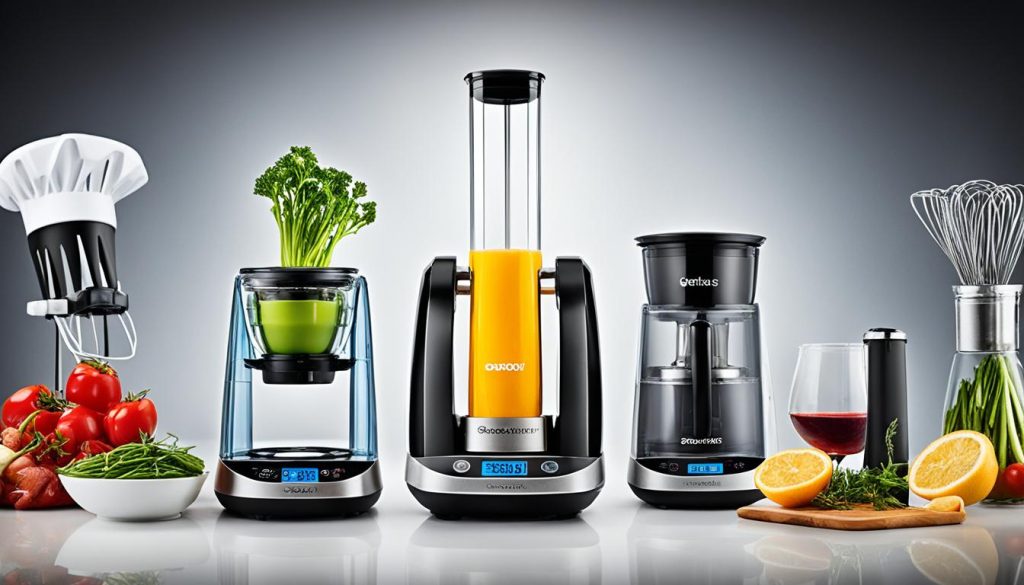When it comes to cooking, using advanced techniques can really boost the flavor of your dishes. These techniques, like sous vide cooking and precise temperature control, help create amazing flavors. They turn simple meals into something special.
By using science and new cooking methods, even home cooks can make dishes that look and taste great. These dishes are not just tasty but also beautiful to look at.
Key Takeaways
- Advanced techniques can unlock new flavor dimensions in your cooking.
- Methods like sous vide ensure precise temperature control for exceptional taste.
- Emulsification plays a crucial role in creating perfect sauces.
- Even home cooks can master professional-level methods with practice.
- Integrating science into cooking can lead to culinary masterpieces.
Understanding Flavor Profiles in Cooking
Learning about flavor profiles is key for those who love cooking. These profiles show the unique taste mixes that make each dish special. They help chefs pick the right ingredients and how to prepare them. By knowing the five basic tastes—sweet, sour, salty, bitter, and umami—cooks can mix these elements to add depth and complexity to their food.
- Sweet: Often found in fruits and certain vegetables, sweet flavors can enhance and balance dishes.
- Sour: Present in citrus fruits and vinegar, sour profiles add brightness and cut through richness.
- Salty: A crucial element that intensifies other flavors, salt can elevate a dish when used correctly.
- Bitter: Found in foods like coffee and dark chocolate, bitter notes can add sophistication and counterbalance sweetness.
- Umami: This savory taste, derived from ingredients like mushrooms and tomatoes, provides depth and richness.
Knowing these flavor profiles is vital for chefs to balance their dishes. It helps them create meals that are not just tasty but also unforgettable.
The Science of Cooking: How Advanced Techniques Improve Taste
The world of cooking science explores the fascinating principles behind how cooking methods affect food’s flavor and texture. By understanding these principles, chefs can make dishes taste better. They use methods that make eating more enjoyable.
One key part of cooking is temperature control. It’s crucial for getting food just right, like perfectly cooked meats or tender veggies. Techniques like roasting or searing start chemical reactions that bring out unique flavors.
Emulsification is another key factor. It’s when ingredients mix together to create a smooth blend of flavors. Knowing how to mix ingredients well helps make dishes that taste great and look appealing.
- The Maillard reaction makes cooked foods brown and taste better.
- Knowing about acids and bases helps balance flavors in recipes.
- Proper hydration changes the texture of food a lot.
By using these culinary techniques, cooks can try new things and make exciting dishes. This leads to culinary innovation that delights the taste buds.
Advanced Techniques in Modern Cuisine
Modern cooking uses advanced techniques to make dishes better. Sous vide and emulsification are two key methods that change how chefs cook and add flavor.
Sous Vide Cooking: Precision Temperature Control
Sous vide is a popular method in modern cooking. It seals food in a bag and cooks it in water at a set temperature. This way, food cooks evenly and keeps its moisture and taste, making it taste great.
Chefs love sous vide for its precision. It helps them cook without guessing, making dishes consistent every time.
Emulsification: Creating Perfect Sauces
Emulsification is key in modern cooking, especially for sauces. It mixes two liquids that don’t mix well, like oil and water, into one. This makes smooth dressings and rich sauces.
Chefs use whisking, blending, or an immersion blender to perfect emulsification. These methods bring out the best in every ingredient.
Utilizing Herbs and Spices for Enhanced Flavor
In cooking, herbs and spices are key for adding amazing flavor. They can turn simple meals into something special. Using fresh herbs like basil, cilantro, and parsley adds brightness. Spices like cumin, paprika, and allspice bring depth and warmth.
Mastering certain cooking techniques is crucial to get the most out of these flavors. Techniques such as infusing oils with herbs or making custom blends create unique tastes. For example, an infused oil can be a tasty base for dressings or marinades, making any dish better.
Knowing the unique qualities of herbs and spices helps cooks use them best. Fresh herbs have a lighter, brighter taste than dried ones, which pack a stronger flavor. Understanding regional flavors can spark creativity in the kitchen. Thyme might remind you of European dishes, while coriander takes you to the Middle East.
Trying out different herbs and spices can lead to exciting discoveries in cooking. As cooks mix flavors and explore global cuisines, they enrich their culinary journey. Using herbs and spices thoughtfully can turn a meal into a memorable event.
Advanced Techniques for Marinating Proteins
Marinating proteins makes them tastier and softer. It’s a key step in cooking meats, fish, and veggies. The right mix of ingredients turns a simple meal into a feast for the taste buds. Knowing how acids work with proteins is key to great results.
The Role of Acid in Marinades
Acids like vinegar, citrus juice, and yogurt do a lot in marinades. They break down tough fibers, making the protein tender. This also helps the marinade flavors go deeper into the meat.
The acidity brightens the taste and balances rich flavors. It makes the dish more complex and interesting.
Infusing Oils and Vinegars with Flavor
Adding herbs, spices, and aromatics to oils and vinegars boosts flavor in marinades. For example, rosemary, garlic, and chili peppers can flavor the oil. This makes it a great base for marinades.
Flavored vinegars can also enhance the taste, taking any dish to the next level. This method lets cooks get creative, adding new twists to classic recipes.
Advanced Techniques for Roasting and Grilling
Mastering roasting and grilling can really boost your cooking skills. These methods lead to the Maillard reaction, a process that makes foods taste better. It’s what gives meats and veggies that amazing flavor and color.
Understanding Maillard Reaction for Better Flavor
The Maillard reaction is key in the kitchen. It happens when foods react to heat, creating new tastes. This is why grilled steaks and roasted veggies taste so good.
When you bite into perfectly grilled meat or roasted food, you get a burst of flavor. This comes from the Maillard reaction. It’s a magic process that makes food taste incredible.
Temperature Management: The Key to Juicy Meats
Keeping the right temperature is crucial for grilling and roasting. It stops meats from drying out and gives them a great sear. Using instant-read thermometers helps you check the meat’s internal temperature.
This ensures your meat is cooked just right. It also makes sure your food stays juicy and full of flavor. This keeps your guests coming back for more.
Exploring different roasting techniques can improve your cooking. These methods will make your meals unforgettable, full of flavor and perfectly cooked.
Enhancing Texture with Culinary Techniques
Culinary texture is key to how we enjoy food. Cooking methods let us change texture for a memorable meal. Techniques like reducing sauces, whipping ingredients, and adding air change a dish’s feel.
Sous vide cooking keeps proteins moist and tender with precise temperature control. Frying gives a crispy outside and a soft inside. This mix of textures makes food more exciting and improves how it looks.
Learning about culinary texture makes dishes better in every way. It’s not just about taste; it’s about a full sensory experience.
Plate Presentation: The Art of Visual Appeal
Plate presentation is key to making dining special. It mixes food aesthetics with culinary art to turn a simple meal into a feast for the eyes. A beautifully presented plate can grab diners’ attention even before they eat.
Here are the main parts of great plate presentation:
- Color Contrast: Bright colors from fresh ingredients make the dish more appealing.
- Layout: How food is arranged on the plate affects how it looks. A balanced layout catches the eye.
- Garnishing Techniques: Garnishes add flavor and make the dish stand out.
Advanced plating lets chefs show off their skills and highlight the beauty of food. Paying attention to these details shows respect for the art of cooking. A great presentation turns every meal into a special event, making it more fun to eat.
Advanced Techniques in Baking
Baking is all about precision and art. Achieving the best bread consistency is key. Using steam baking is a top method for better texture and flavor.
Using Steam for Moisture in Bread Baking
Steam is vital for a great crust and keeping bread moist. It helps the bread spring up in the oven, making it light and fluffy inside. Here are some tips for using steam in your baking:
- Preheat a baking stone in your oven to help retain heat.
- Add hot water to a pan on the bottom rack of your oven just before putting in the dough.
- Spritz the dough with water before closing the oven door.
These tips can make your homemade bread taste like it came from a bakery. Getting good at steam baking will make your bread better in taste and texture. It turns each loaf into a treat.
Culinary Techniques from Around the World
Exploring global culinary techniques opens up new flavors. Different cultures have their own methods that have lasted for years. These methods give us new ways to make food and share flavors from around the world.
Fermenting is a key technique used in many cultures. It keeps food fresh and makes it taste better. Pickling adds a tangy taste to food, making each ingredient stand out. Smoking gives food a deep flavor, adding layers of taste to meats and vegetables.
Cooks can use these techniques in their kitchens to make new dishes. Mixing global culinary techniques lets you try new ingredients and flavors together. This makes cooking more fun and exciting.
- Fermenting: Enhances flavors while preserving ingredients.
- Pickling: Adds acidity and brightness to dishes.
- Smoking: Introduces a savory depth to proteins and vegetables.
Learning these methods helps us appreciate international cuisines more. Cooks can adapt and try new things, making dishes that reflect different cultures. This improves their cooking skills.
Conclusion
In the culinary world, using advanced techniques is key to boosting flavors and making meals special. Chefs learn about the science of cooking to make dishes that excite the taste buds.
Modern methods like sous vide and emulsification help cooks of all levels. They bring together techniques from around the world. This approach encourages creativity and precision in every dish.
Cooking is more than just a task; it’s an art filled with joy and endless possibilities. By using these advanced methods, anyone can improve their cooking skills. This opens the door to creating unforgettable meals.



